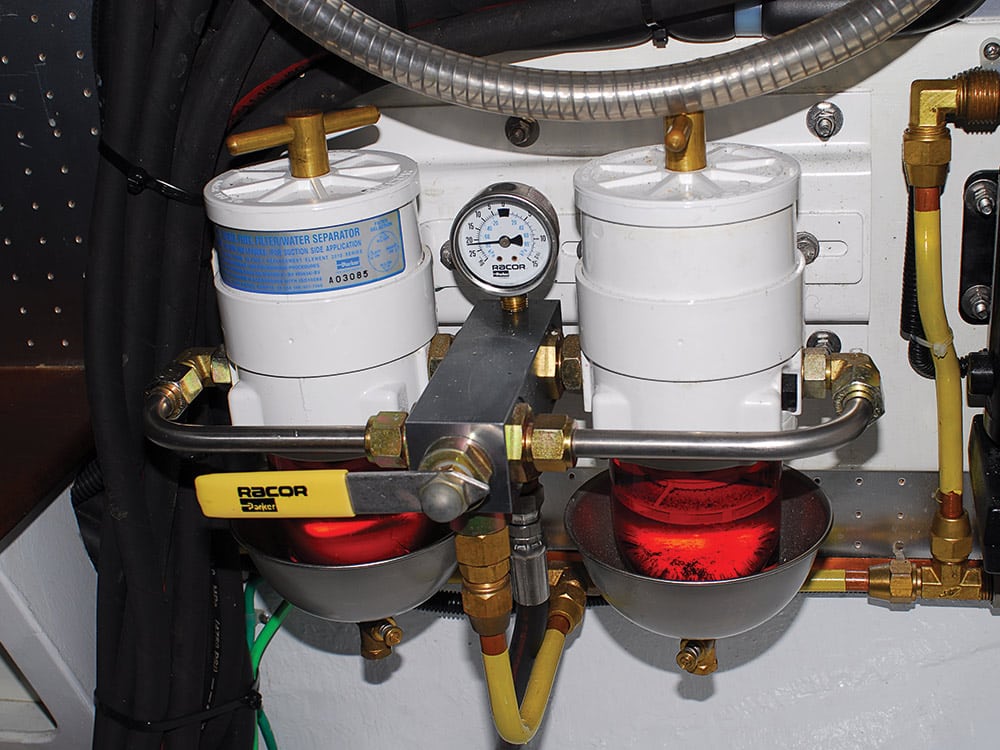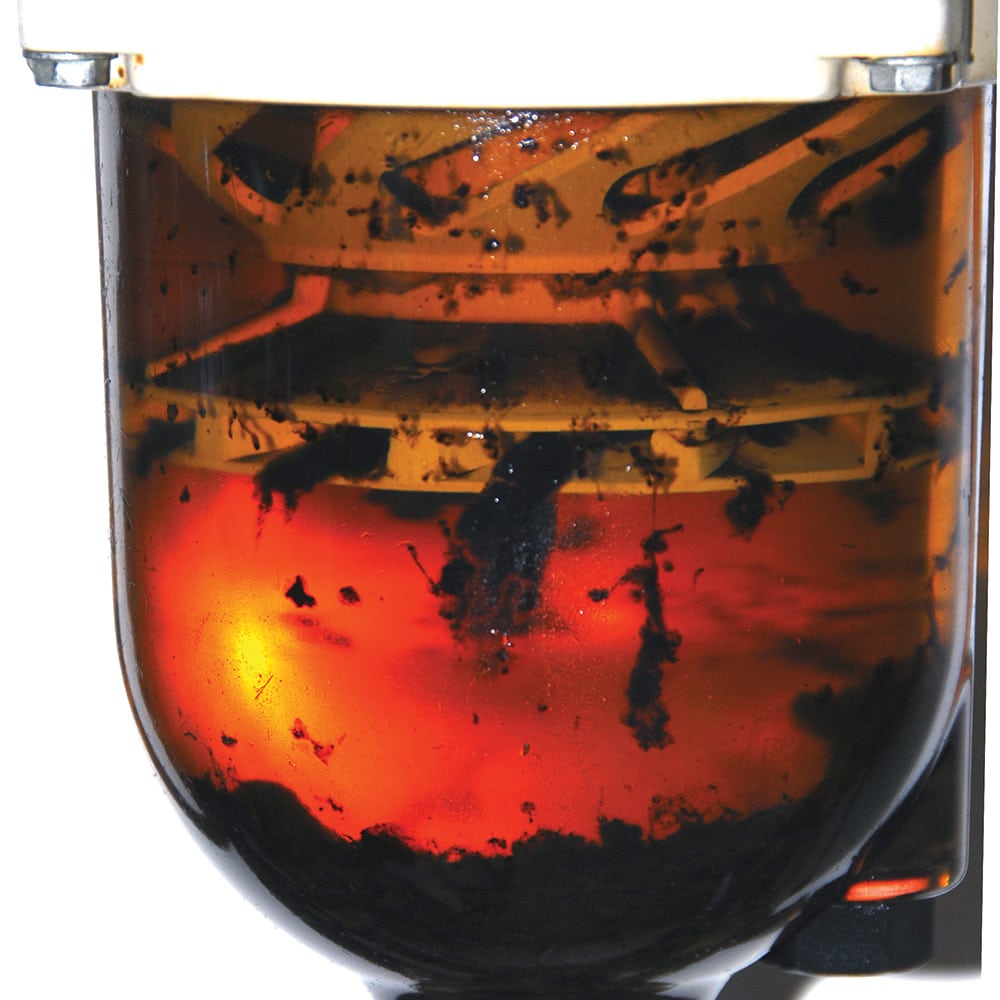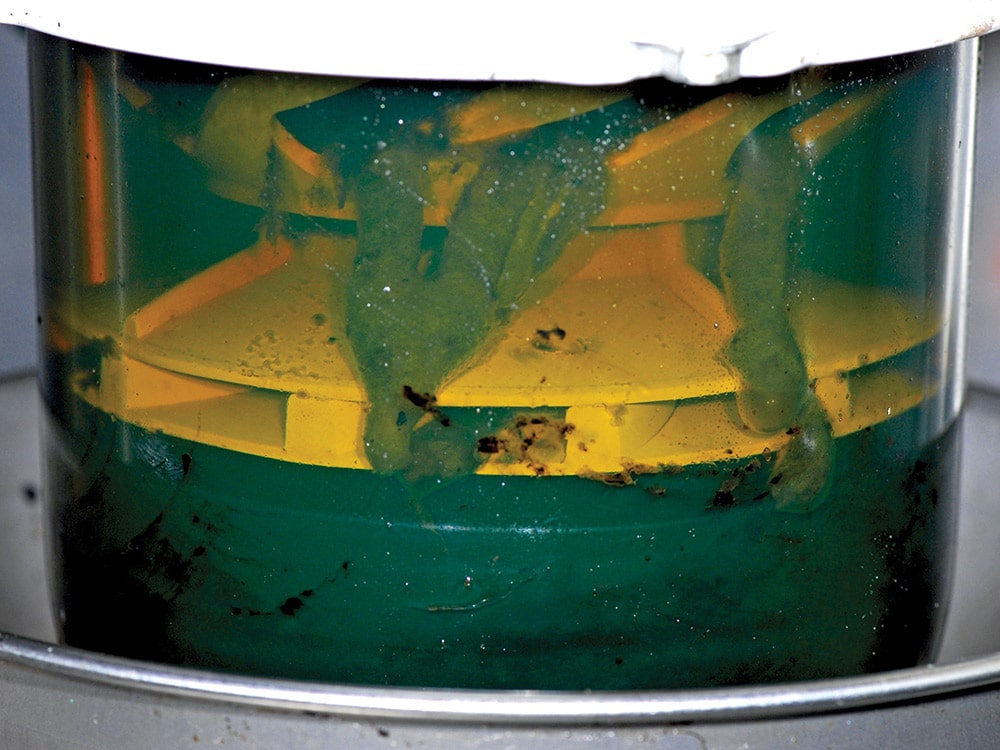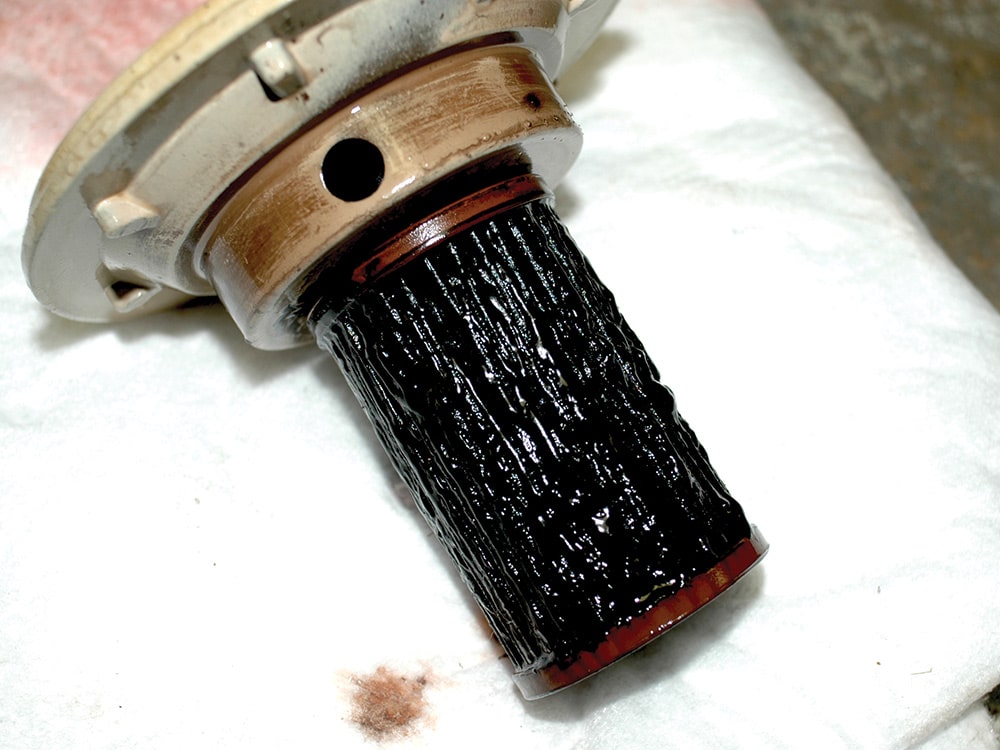
In the pantheon of sailing saints, nestled between St. L. Francis Herreshoff and Father Joshua Slocum, I propose that we canonize Rudolf Diesel as the patron saint of the windless wanderer. For it was Diesel who, in 1892, had a revolutionary idea regarding the fledgling internal combustion engine. He postulated that if the compression ratio was sufficiently high as to create intense heat and a viscous fuel was injected in a vaporized form, there would be no need to introduce a high-voltage spark to create ignition. For many years, these large-lunged thumpers did not change significantly. Their strength was in their robust simplicity. Their fault lay in their ponderous weight and sooty emissions. Through spurts of evolutionary design, those faults have disappeared in the modern diesel. What remains is a long list of clear advantages over gasoline engines. The weight-to-power ratio now outstrips the gasoline engine, the fuel economy is approaching twice that of petrol, the emissions are markedly more environmentally friendly and, if given clean oil, fuel and air, the reliability and longevity are legendary. In the European passenger- vehicle market, diesel engines now outnumber their gasoline cousins, and of course, diesels totally dominate freight transport on the rails, highways and oceans. For the cruising sailor, however, the most critical difference is safety. Whereas gasoline is highly vaporous and explosive, diesel emits little vapor and is almost impossible to ignite. When burned, it creates far less carbon monoxide than gasoline, an important consideration in small and relatively unventilated spaces. But diesel oil, as it is sometimes called, is a complex fuel with a long list of properties, such as lubricity, cetane rating (equivalent to octane in gasoline) stability and cold-weather performance.
Buyer Be Aware
Our first consideration should be at the point of purchase. While still stateside, one can be reasonably sure they are getting a fresh and clean product. Still, it may pay to have a close look at the marina or other outlet selling that fuel. If the docks and slips are neglected, so too may be the stowage tanks. When were they last cleaned? How much volume has been put through? If even remotely suspicious, pump the first quart into a glass jar or clear plastic container. The fuel should be bright and clear. Some areas tax recreational diesel at a higher rate than highway outlets and add a marker dye to police that policy. These are harmless and do not mask contaminants.
Twenty years ago, diesel oil had a shelf life of 1½ to two years. Due to heightened environmental regulations, today’s fuel is required to be ultralow sulfur. This makes it more vulnerable to microbial contamination. Also, due to insatiable demand from China and other developing nations, refineries are forced to crack the fuel in ways that increase volume but decrease quality. Now, decline in fuel quality can be detected in as little as six months.

Even where you live can affect the nature of the fuel. In extremely cold areas, such as New England, many fuel docks will sell No. 1 diesel instead of the standard No. 2 throughout the winter months. This has less paraffin, as it tends to wax up in extreme low temperatures and can block fuel lines. This practice results in less lubrication and can ultimately affect engine life. Increasing pressure to mandate the use of a biodiesel called FAME (fatty acid methyl ester) may present yet more challenges.
Once purchased, the fuel in the vessel’s main tank typically is held in a cool and dark environment that inhibits condensation and certain types of degradation. Not so for those ungainly jerrycans lashed to the lifelines. Multiple heating and cooling cycles promote copious condensation. Also, diesel exposed to sunlight (uncommon in normal situations) finds an encouraging environment for the growth of algae. I have always maintained that the only proper place for diesel is in the diesel tank. But if built-in capacity forces you to carry cans on deck, cover them from the sun, do not siphon or pour out the last dregs, and rotate the fuel in them often.
Water, Water Everywhere
Our job is not done once the amber liquid is in the tank, for there lurks a cabal of interrelated threats. These include oxidation, condensation, gel, sludge, rust particles, dirt, gums, varnish and an ugly plethora of microbial enemies both fungal and bacterial.
The single greatest threat to clean diesel is water because it not only has destructive properties itself, but promotes flow-on problems. Most engine manufacturers recommend a maximum of 200 parts per million. When exposed to oxygen or oxygen-bearing substances, the fuel naturally oxidizes. Water is, of course, one part oxygen and two parts hydrogen. Further, microbes need water to multiply and, in the process, produce acids that destroy fuel quality, corrode tanks and engine parts, and clog filters.
Clear signs of water in the fuel are irregular idling, excessive black or white smoke, and rapidly clogging filters. Your first line of defense is to keep the tanks as full as possible to reduce condensation.
But once in, there are two diametrically opposed strategies to deal with water problems, depending on the quantity of the moisture and how early it has been detected. These are emulsifiers and anti-emulsifiers.
Emulsifying additives break the water droplets down to particulate size, called micelles, so that they suspend in the fuel and pass somewhat harmlessly through the fuel filter and are burned. Anti-emulsifiers coalesce water into gummy lumps that drop to the bottom of the tank and, unless stirred up, remain below the pick-up pipe and eventually can be vacuumed out.
Another issue encouraged by ultralow sulfur content is the agglomeration of asphaltenes into an oily sludge that can block filters in as little as 50 hours of operation. A different type of additive called a stabilizer is required to combat this threat.

Sludge Drudgery
Next, we must deal with foreign growth in fuel with biocide additives. The diesel tank is a perfect petri dish for bacterial growth. It boasts water for germination, carbon for food, oxygen and sulfur for respiration, and trace elements for growth and propagation. So splendid is this environment that minute amounts of bacteria can explode into thick layers of pond scum that no filtration system can cope with. Add in fungal growth that forms robust mycelia mats to ensure a complete shutdown, usually at the moment of no return when entering a narrow coral pass.
Bacterial and fungal issues require different formulas of biocide. The marketplace has responded to these low-sulfur problems with a complex line of products to treat this confusing array of issues. There are two strategies, one a general shotgun approach and the other as focused as a target rifle.
As a preventive measure there is a plethora of additive brands that combine conditioners, emulsifiers, cetane-rating enhancers and general biocides that inhibit both bacterial and fungal growth. They increase the fuel’s lubricity, which reduces friction, extending engine life. Given the initial expense of any diesel engine, they are well worth their cost and should be used on a regular basis.
All the promotional calculations of the additives’ cost versus miles-per-gallon efficiency has little relevance to cruising sailors because we do not put enough hours on our vessels to make that cost significant. Nor do the claims of added power, for we are not hauling tons of cargo uphill, but rather pulling a relatively light load at constant rotations per minute through a somewhat standard medium. Let the long-haul trucker running many thousands of gallons per year through their vehicle crunch those numbers. What we need most is stability for fuel that sits for long periods in our tanks, and a reasonable purity once it is finally burned.
However, once a problem is detected vis-à-vis sludge, gel, black particles or general cloudiness, these multitasking products will not be strong or specific enough to effect a cure. The littlest bit of bacteria, nestled into a hairline crack in the steel tank liner, can survive a general treatment and escape to go forth and multiply. You must scoop up a quart of fuel and take it down to a professional diesel lab for analysis. Once the problem is identified as fungal, bacterial, hydrolysis, asphaltene, foreign debris or simple degradation, you can select the appropriate additive that’s strong enough to address your specific problem.
Ensure that the biocide is well-mixed with the fuel by going for a lively sail, or at the least, use a series of forward and reverse motions dockside. Be sure to give any separated day tank the prescribed treatment lest you reintroduce the problem via the injection pump return line. After introducing a biocide, plan to replace the filters after 10 hours of use because it will inevitably kill off a significant volume of organic matter.
Pressure’s On
When I mentioned earlier the elegant simplicity of the diesel engine I was excluding the injection pump, which is undoubtedly the most complex piece of equipment you are ever likely to own. Its tolerances are measured in ten-thousandths of an inch, pressure in the tens of thousands of psi. Orifices measure in microns less than the width of a human hair. This demands uncompromised cleanliness. A professional injection-pump shop looks like a surgery unit, complete with white robes, hairnets and gloves. This explains why that little pump alone constitutes more than 30 percent of the entire engine’s cost.
To protect that finicky investment, the fuel should pass through an efficient sequential filtration system. This begins with a relatively large and coarse initial filter/water separator, leading to a smaller and finer filter mounted on the engine. The main cartridge has a hydrophobic barrier made of silicone-treated cellulose. The repelled water particles coalesce into droplets that fall to the bottom of the filter housing bowl, where they can be sighted (in the case of clear bowls) and occasionally drained via a low tap.

Debate rages as to how many filters are required, how large, and how many microns they should be. The nuanced answer is: It depends. First, on how meticulous one has been in the sourcing, stowage and remedial treatments of the fuel. Next is how convenient it is to access the system for regular water drainage, filter changes and bleeding once the system has been cracked open.
The manufacturers recommendations are general guidelines that do not take into consideration the gallons-per-hour consumption of your specific engine, nor the average hours of operation. There are earthmovers sucking barrels per hour, generators running 24/7, and then there are the purist sailors who struggle to remember where the starter switch is. We sailors can get away with smaller and finer filters simply because we push less volume through them. But, however counterintuitive it may sound, this can be overdone. Multiple filters with small micron ratings can result in higher vacuum pressure. This can ultimately damage the O-rings and gaskets on the engine lift pump and result in injection-pump inefficiency or even failure.
I have successfully used the “10-2 System” for decades. My initial filter is a 10-micron Racor with a spinning water separator, and the engine-mounted final filter is a 2-micron cartridge. I change them at least as often as the engine oil, which means every 200 hours of operation or at the annual spring recommission, whichever comes first.
Don’t rely on your memory; tempus fugit. Install a proper Hobbs meter (engine-hour clock) to accurately track maintenance history, and mark on all filters with large numbers the date of change and engine hours at that time.
But if you are the belt-and-suspender type you may consider a bypass system in the event of a sudden shutdown, or a circular fuel “polishing” system to prevent such. The bypass is simply a diverter valve that funnels the fuel to an independent pre-filled filter and rejoins the main fuel supply line downstream of the original filter. It is important to isolate the primary filter at both ends via a Y-valve or add-itional shutoffs.
Because a polishing system operates independent from the engine, it requires a fuel-safe 12- or 24-volt pump capable of creating sufficient pressure to lift fuel from the main tank, force it through a filtration system and return it to the tank. As this requires ample engine-room space and usually comes at considerable cost, you may consider the services of a professional fuel polisher instead, who, in situ, will vacuum any sludge and debris from your tank bottom and run your fuel through a high-volume filtration system. This might be money well spent before a major offshore venture.
In conclusion, if you source, store, condition and filter your fuel as described, you can be almost guaranteed that Old Smokey will be less so, and purr away happily for many wonderful years and miles to come.
Alvah Simon is a veteran circumnavigator, writer and CW contributing editor.








